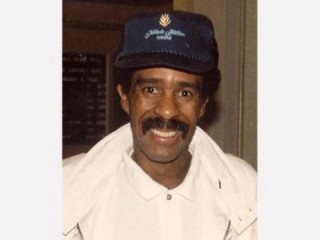
Richard Pryor biography
Date of birth : 1940-12-01
Date of death : 2005-12-10
Birthplace : Peoria, Illinois
Nationality : American
Category : Arts and Entertainment
Last modified : 2010-11-22
Credited as : Actor and Standup Comedian, political comedy,
0 votes so far
Richard Pryor was born December 1, 1940, in Peoria, IL. His early life was confusing and difficult; raised in the brothel owned by his grandmother, Pryor's mother was herself a prostitute, and his father was a pimp. Living in the worst slum in the Peoria area, he often found himself the target of gang violence; his sense of humor was his only defense mechanism, and Pryor soon developed a reputation as a class cut-up. By the age of 14, he was performing with a local amateur dramatic group, and in 1964 he relocated to New York City to pursue a career in standup. At the outset of his career, Pryor struggled to find his own voice: on his self-titled 1968 debut, he slavishly imitated the rhythms and themes of Bill Cosby on routines like "Adam and Eve" and the nostalgic "Girls," and only a bit about a black superhero -- dubbed "Supernigger" -- offered any hint of things to come.
Pryor continued performing safe, toothless comedy for another couple of years, but during a 1970 Las Vegas appearance he snapped; in the middle of the routine, he rhetorically asked, "What am I doing here?" and walked offstage, effectively going underground and playing only small black clubs for much of the early part of the decade. This period, along with his late-'60s work, served as the basis for an onslaught of LPs issued by the Laff label throughout the 1970s; while a part of his official discography, the material found on albums like 1977's Are You Serious???, 1978's Black Ben the Blacksmith, and 1980's Insane was already many years old by the time of the records' release. Not surprisingly, Pryor later disowned the albums.
By the time Pryor resurfaced in 1974 with the Top 40 hit That Nigger's Crazy, he was a changed man; no longer did mainstream concerns force him to suppress his bitterness toward the white establishment -- now he took on issues of racism with fire-breathing intensity, regardless of the consequences. Much to the surprise of many pundits, however, Pryor's career soared -- black audiences adored him, of course, but liberal white audiences lined up for his concert appearances as well. 1975's Is It Something I Said? fell just shy of the Top Ten on the strength of routines like "When Your Woman Leaves You," a poignant assessment of Pryor's well-publicized series of marriages and divorces, while the centerpiece of 1976's Bicentennial Nigger explored two centuries of white oppression with incendiary fury. Major roles in a pair of 1977 features, Silver Streak and Greased Lightning, preceded the debut of The Richard Pryor Show, a variety series for NBC; from the program's inception, he and the network battled constantly over the show's perceived "bad taste," and its run lasted only five weeks.
Pryor's life was spinning rapidly out of control; while still smarting from the NBC debacle, he made headlines that New Year's Eve for drunkenly shooting up his wife's car. The incident became the basis of his opening routine for 1978's Wanted: Live in Concert, an ambitious two-record set that led to the 1979 feature Richard Pryor: Live in Concert, a highly successful film document of his stage act. As his career again looked on the upswing, however, tragedy struck: in June 1980 Pryor nearly burned to death, a mishap variously attributed to a freebasing accident and a misguided attempt at suicide. A long recovery period followed, as he struggled both to kick his longtime drug habit and rediscover his creative energies; a trip to Africa ultimately renewed him spiritually, and he returned to America a new man, one who declared he would never use the word "nigger" again.
It was a wiser, more mature Pryor who resurfaced in 1982 with the film and album Live on the Sunset Strip, in which he discussed both his brush with death and his odyssey to Africa. His humor turned gentler and more introspective, and while his standup retained its edge, his career as a film actor suffered through lightweight, pedestrian comedies like The Toy, Brewster's Millions, and Critical Condition. 1983's Here and Now was his final concert film and album; three years later, Pryor was struck with multiple sclerosis, effectively ending his career as a standup performer. He appeared in a few more film roles before the disease began to cripple him; following 1991's dismal Another You, he largely disappeared from sight. Finally, in 1997 a wheelchair-bound Pryor made a brief appearance in David Lynch's Lost Highway. An autobiography, Pryor Convictions and Other Life Sentences, was published in 1995. Five years later, Rhino addressed the sad state of Pryor's back catalog with the release of ...And It's Deep, Too!: The Complete Warner Bros. Recordings (1968-1992). The critical and commercial success of the box set later prompted Rhino to release The Richard Pryor Anthology: 1968-1992 (a two-CD compilation of highlights from ...And It's Deep, Too!), and Evolution/Revolution: The Early Years (1966-1974) (another double-disc set that gathered much of the stray material used to compile the albums released by Laff).
Pryor passed away on December 10, 2005, finally succumbing to his long bout with multiple sclerosis. He suffered a heart attack and died in a hospital in Los Angeles. He was 65. He was widely commemorated as an iconoclastic comedian who transcended barriers of race and opened the door for such followers as Eddie Murphy, Chris Rock, Bernie Mac, and Dave Chappelle.
















